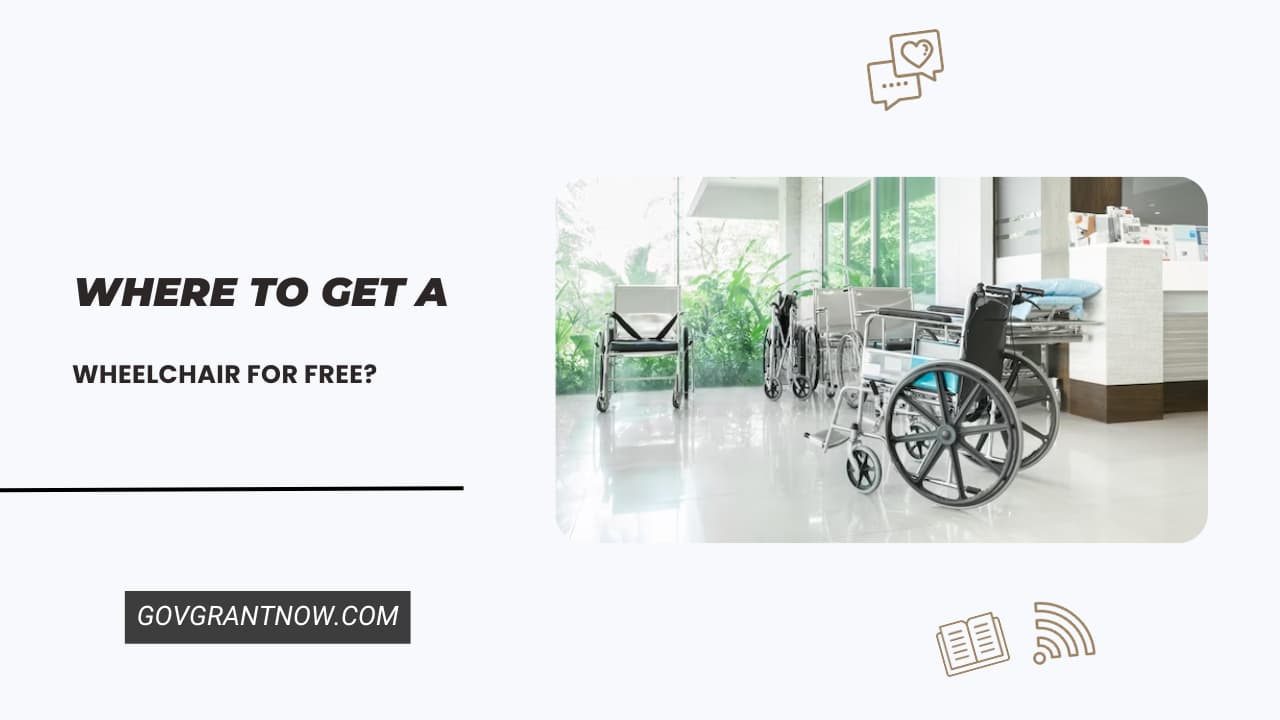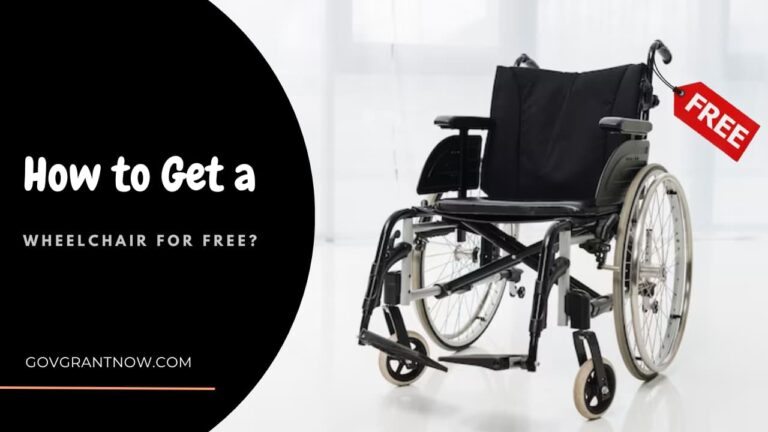Do you or a loved one need a wheelchair but are worried about the cost? This comprehensive guide is designed to help seniors and the disabled navigate the often challenging process of getting a free wheelchair.
We understand that mobility is a critical aspect of independence and quality of life, especially in our golden years.
With this in mind, we explore the various avenues available for seniors and the disabled to get a wheelchair at no cost.
From navigating eligibility criteria and government programs to unleashing resources in support of non-profit organizations, charitable foundations, and the local community – we cover it all.
We aim to demystify the process and provide you with a clear, step-by-step guide on how to access these essential mobility aids.
Whether it’s understanding the application process or exploring alternative solutions, this article serves as your resource for all things related to getting a free wheelchair for seniors and the disabled.
Let’s move towards greater mobility and freedom together.
Table of Contents
Who Qualifies for Free Wheelchairs?

To qualify for a free wheelchair, the eligibility criteria can vary depending on the program or organization providing the wheelchair.
However, in general, the following groups are often considered eligible:
- Individuals with Mobility Impairments: The primary qualification is usually having a medical condition that significantly impairs mobility, making a wheelchair a necessity for daily living activities.
- For Seniors: Older adults, typically those aged 65 and above, are often prioritized by programs aimed at assisting seniors.
- For Disabled: Individuals with disabilities usually need to provide documentation or certification of their disability. This often includes a medical diagnosis and a statement from a healthcare provider indicating the necessity of a wheelchair.
- People with Low Income: Many programs target individuals and families with limited financial resources. Applicants may need to provide proof of income or demonstrate financial hardship.
- Those Lacking Insurance Coverage: Individuals who do not have medical insurance that covers durable medical equipment like wheelchairs, or whose insurance only covers a part of the cost, often qualify.
- Residents of Specific Areas: Some programs are restricted to residents of certain regions, states, or countries.
- Individuals Without Other Means: Priority is often given to those who lack other means of obtaining a wheelchair, such as personal funds or family support.
- People with Specific Medical Conditions: Some organizations may focus on specific medical conditions or disabilities that necessitate the use of a wheelchair.
Where to Get a Wheelchair for Free?

There are several resources where individuals can get free wheelchairs, especially seniors and the disabled.
Here are some primary resources that can help seniors and the disabled get free wheelchairs:
1. Medicare
Medicare, under its Part B coverage, provides support for durable medical equipment (DME), including wheelchairs.
This coverage is contingent on medically necessary equipment, as prescribed by a physician enrolled in the Medicare program.
The types of wheelchairs covered by Medicare vary, including manual wheelchairs, power wheelchairs, and scooters.
The specific type provided is based on the individual’s unique medical condition and mobility needs.
For a patient to qualify for a wheelchair under Medicare, they must first obtain a prescription from a Medicare-registered doctor.
The process usually involves an in-person medical consultation, where a doctor assesses the patient’s mobility needs and determines whether a wheelchair is necessary.
The prescription must clearly state the medical reasons for the wheelchair, such as the patient’s inability to use a cane or other mobility aid such as a walker.
Regarding the acquisition of a wheelchair, Medicare has specific rules about where it can be obtained. Equipment must be obtained from a supplier that is officially enrolled in the Medicare program.
In areas where Medicare conducts competitive bidding, patients may be required to rent or purchase their wheelchairs from a group of approved suppliers.
It is also important to pay attention to the cost-sharing aspect of Medicare coverage.
After the patient meets their annual Part B deductible, Medicare typically pays 80% of the amount allowed for the wheelchair. The patient is responsible for the remaining 20% co-payment.
However, this can be mitigated if the patient has a Medigap (Medicare Supplement Insurance) policy, which can cover these additional costs.
How to Apply:
- Consult a Doctor: Start by consulting with a healthcare provider who participates in Medicare.
- Medical Evaluation: Have a face-to-face examination and obtain a written prescription.
- Find a Medicare-approved Supplier: Locate a supplier that is enrolled in Medicare and adheres to its standards.
- Submit the Claim: The supplier typically submits a claim to Medicare on your behalf.
2. Medicaid
Medicaid, a joint federal and state program in the United States, provides essential health coverage to various groups, including low-income individuals, people with disabilities, and the elderly.
This program is especially important when it comes to helping with the cost of medical necessities like wheelchairs.
Medicaid’s role is to ensure that those who need this mobility assistance for medical reasons can access it.
Coverage for wheelchairs falls under the umbrella of durable medical equipment (DME), which Medicaid typically covers.
However, the exact details of this coverage may vary from state to state, as each state operates its own Medicaid program within broad federal guidelines.
This difference means that eligibility criteria, the type of wheelchair covered and any associated costs such as co-payments may differ.
To get a wheelchair through Medicaid, a person needs a prescription from a healthcare provider to establish the medical necessity of the wheelchair.
This process includes a medical evaluation to assess the person’s mobility needs.
Once a prescription is obtained, the individual or their caregiver must coordinate with a Medicaid-approved durable medical equipment supplier to receive the wheelchair.
The supplier, in many cases, handles most of the paperwork and coordination with Medicaid.
For Medicaid-eligible individuals, this program provides an important means of accessing the wheelchair they need, ensuring that mobility issues are not complicated by financial barriers.
Individuals seeking a wheelchair through Medicaid need to check with their healthcare provider and contact their state Medicaid office for detailed information and guidance on the application process and specifics of coverage.
How to Apply:
- Consult with a Healthcare Provider: Begin by discussing mobility needs with a healthcare provider who can evaluate the necessity for a wheelchair.
- Medicaid Enrollment: Ensure enrollment in Medicaid. If not already enrolled, individuals can apply through their state’s Medicaid program.
- Locate an Approved Supplier: Find a DME supplier that accepts Medicaid and can provide the prescribed wheelchair.
3. Non-Profit Organizations
Non-profit organizations play a significant role in providing free wheelchairs to the needy, including seniors and individuals with mobility impairments.
These organizations often operate through donations, grants, and volunteer efforts, focusing on improving accessibility and quality of life for people who cannot afford or access wheelchairs through traditional means.
Non-profit organizations usually offer wheelchairs at no cost or a significantly reduced cost.
They operate at different scales, from local community groups to international charities.
These organizations often have specific programs for free wheelchairs, and may also offer mobility aids and other forms of support services.
One of the key aspects of non-profits is their ability to fill gaps left by government programs and insurance coverage, which may not be accessible to everyone.
They often have more flexible eligibility criteria, focusing on an individual’s needs and circumstances rather than strict income or medical guidelines.
For those seeking assistance from non-profit organizations, it is recommended to research and contact various groups to understand their application process, eligibility criteria, and the types of wheelchairs they provide.
These organizations not only provide resources for wheelchair access but often provide a supportive community and additional resources for individuals with mobility issues.
here is a list of non-profit organizations that help with free wheelchairs and mobility aids:
- The Wheelchair Foundation: An international organization focused on providing free wheelchairs to those in need around the world, regardless of their financial situation.
- Chariots of Hope: Dedicated to collecting, repairing, and distributing used wheelchairs at no cost to individuals across the globe.
- Free Wheelchair Mission: Specializes in designing and manufacturing cost-effective wheelchairs for distribution in under-resourced nations.
- Hope Haven International: Known for distributing wheelchairs worldwide, they also focus on providing mobility devices to children.
- LifeNets Wheelchair Project: Operates a program specifically for collecting and redistributing used wheelchairs to those who need them.
- Alternatives in Motion: Provides mobility equipment to individuals who lack the resources to obtain it on their own.
- Joni and Friends Wheels for the World: Offers wheelchairs and mobility aids along with training and spiritual encouragement.
- Direct Relief: While primarily a medical aid organization, they also provide wheelchairs and other medical supplies worldwide.
- Convaid Wheelchairs: Known for their work with children, providing specialized wheelchairs and mobility solutions.
- Miracle on Wheels: Provides assistance for individuals to receive mobility aids, including wheelchairs.
4. Charitable Foundations
Charitable foundations often play a critical role in helping individuals with disabilities, including seniors, by providing funding and resources for wheelchairs and other mobility aids.
These foundations generally focus on philanthropy and aim to improve the quality of life and accessibility for those in need.
Charitable foundations operate by collecting donations from individuals, businesses, and other organizations.
They then use these funds to support various charitable causes, including the provision of wheelchairs and mobility aids.
These foundations can work independently or in collaboration with non-profit organizations and healthcare providers.
here is a list of charitable foundations that provide free wheelchairs and mobility aids:
- The Christopher and Dana Reeve Foundation
- Muscular Dystrophy Association (MDA)
- United Spinal Association
- Wheelchair Foundation
- Chariots of Hope
- Free Wheelchair Mission
- Jon Bon Jovi Soul Foundation
- Variety – The Children’s Charity
- Independence First
- Lions Clubs International
- Kiwanis International
- Knights of Columbus
5. Community Centers
Local community centers, churches, senior centers, and disabled centers are valuable resources for seniors seeking wheelchairs.
They provide information about local programs and organizations that offer wheelchairs or financial assistance.
These centers promote community, host events, and offer support groups that help seniors find resources for improved mobility.
Volunteers associated with these organizations often play an important role in connecting seniors with the help they need.
Seniors and their caregivers can consult these local community resources to explore specific resources and support available in their area.
How to Apply for a Free Wheelchair?

Applying for a free wheelchair involves several steps, and the process can vary depending on the specific program or organization offering the assistance.
Here are the important points to consider when applying for a free wheelchair:
Step 1. Research Available Programs:
Start by researching and identifying programs, non-profit organizations, or government initiatives in your area that offer free wheelchairs.
Local senior centers, disabled centers, community organizations, and healthcare providers can provide valuable information about such programs.
Step 2. Determine Eligibility:
Each program may have its own eligibility criteria, which can include factors like age, income level, medical condition, and mobility needs.
Determine whether you meet the eligibility requirements for the programs you’re interested in.
Step 3. Gather Documentation:
Prepare the necessary documentation to support your application. This may include proof of income, medical records or prescriptions from a healthcare provider, and any other documentation requested by the program.
Step 4. Contact the Program:
Reach out to the program or organization offering free wheelchairs. Contact them by phone, email, or through their website to inquire about the application process.
Ask for guidance on what documents you need to submit and any specific forms to fill out.
Step 5. Submit the Application:
Complete the application forms provided by the program and submit them along with the required documentation.
Ensure that you provide accurate and up-to-date information to facilitate the application process.
Step 6. Wait for Review:
Once you’ve submitted your application, the program will typically review your eligibility and documentation. This process may take some time, so be patient.
Step 7. Assessment:
In some cases, you may be required to undergo an assessment by a healthcare professional to determine your specific wheelchair needs.
This assessment ensures that you receive the most suitable wheelchair for your mobility requirements.
Step 8. Approval and Delivery:
If your application is approved, the program will notify you and arrange for the delivery of the wheelchair. They will also provide instructions on how to use and maintain the wheelchair properly.
Step 9. Follow-Up and Support:
Stay in contact with the program or organization that provided the wheelchair. They may offer support, maintenance services, or additional assistance if needed.
What Can I Do If I Don’t Qualify for the Free Wheelchair Program?
If you do not qualify for the free wheelchair program or if you are looking for alternative ways to get a wheelchair, here are some options to consider:
- Health Insurance Coverage: Check your health insurance policy, including Medicare or Medicaid, to see if they provide coverage for wheelchairs. Depending on your plan and medical necessity, they may cover a portion of the cost of a wheelchair.
- Purchase: You can purchase a wheelchair through medical supply stores, online retailers, or directly from manufacturers. While this involves a financial investment, it gives you the flexibility to choose the type and features of the wheelchair that best suits your needs.
- Renting: If you need a wheelchair temporarily, consider renting one. Many medical supply stores offer wheelchair rental services. This option can be cost-effective for short-term mobility needs.
- Used Wheelchairs: Look for second-hand or used wheelchairs, which may be available at a lower cost. Ensure that any used wheelchair you consider is in good condition and meets your specific requirements.
- Assistive Technology Loans: Some organizations or financial institutions offer loans or financing options specifically for assistive technology, including wheelchairs. These loans may have favorable terms and low interest rates.
- Charitable Organizations: Explore charitable organizations, foundations, or nonprofits that provide financial assistance to individuals in need of mobility aids. They may offer grants or funding to help cover the cost of a wheelchair.
- Veterans Affairs (VA) Benefits: If you are a veteran, the VA may assist with obtaining a wheelchair if it is related to a service-connected disability or medical condition.
- Community Fundraisers: Consider organizing or participating in community fundraisers, crowdfunding campaigns, or charity events to raise funds for a wheelchair purchase.
- Local Assistance Programs: Check with local government agencies, disability services, or community organizations that may have programs or funds to assist individuals in obtaining mobility aids.
- Donations and Gifts: Reach out to family, friends, or social networks to see if anyone can assist with the cost of a wheelchair through donations or gifts.
How Much Does a Wheelchair Cost?

The cost of a wheelchair can vary widely depending on several factors, including the type of wheelchair, brand, features, and where it’s purchased.
Here are the different types of wheelchairs and their prices:
1. Manual Wheelchairs:
- Basic Transport Wheelchair: These lightweight wheelchairs are the least expensive and typically cost between $100 and $300.
- Standard Manual Wheelchair: A standard manual wheelchair with more features and comfort can range from $300 to $1,000 or more.
- Lightweight and Ultra-Lightweight Wheelchairs: These are designed for easier maneuverability and can cost between $1,000 and $3,000.
2. Power Wheelchairs:
- Basic Power Wheelchairs: Basic models may start at around $1,000 to $2,000.
- Mid-Range Power Wheelchairs: These offer more features and customization options and can range from $2,000 to $5,000.
- High-End Power Wheelchairs: Advanced power wheelchairs with specialized features can cost $5,000 or more.
3. Custom or Specialty Wheelchairs:
Customized wheelchairs designed for specific medical conditions or unique needs can vary widely in cost, often starting at $5,000 and going up significantly.
4. Bariatric Wheelchairs:
Bariatric wheelchairs designed for individuals with higher weight capacities may cost more than standard wheelchairs, ranging from $500 to $2,000 or more.
5. Sports or Recreation Wheelchairs:
Wheelchairs designed for sports or recreational activities can vary in cost, with some specialized models costing several thousand dollars.
Benefits of Getting a Free Wheelchair for Seniors and Disabled

Seniors and the disabled receive many benefits from having a free wheelchair, which significantly affects their quality of life and overall well-being.
Here are the benefits of getting a free wheelchair for seniors and the disabled:
- Financial Relief: Access to a free wheelchair can alleviate the financial burden associated with purchasing or renting a mobility aid. This can free up resources for other essential needs, such as healthcare or housing.
- Enhanced Mobility: Free wheelchairs enable seniors and the disabled to regain or improve their mobility. This new freedom allows them to move around their homes and communities, engage in daily activities, and maintain a sense of independence.
- Improved Quality of Life: Increased mobility and the ability to participate in daily activities contribute to a better quality of life for seniors and the disabled. They can continue to enjoy hobbies, visit friends and family, and remain engaged in their communities.
- Physical Health: Wheelchairs provide support and reduce physical stress on seniors and the disabled with mobility challenges. This can result in better posture, reduce the risk of falls, and improve overall physical health.
- Mental Health: Maintaining mobility and independence has a positive impact on mental well-being. Seniors and people with disabilities who move around freely are less likely to experience feeling lonely, depressed, or anxious.
- Access to Healthcare: Seniors and people with disabilities with wheelchairs can more easily access healthcare services, attend medical appointments, and receive needed treatment, leading to better overall health outcomes.
- Safety: Wheelchairs provide a safe means of mobility, reducing the risk of accidents or injuries that can occur when seniors and the disabled attempt to move without proper support.
- Maintaining Independence: The ability to move independently allows seniors and the disabled to maintain their dignity and independence. They can continue to make decisions and perform daily tasks without relying too much on others.
Conclusion:
This guide provides valuable insight for seniors and the disabled on how to get a wheelchair for free, addressing a critical aspect of maintaining independence and mobility. It details eligibility criteria, including individuals with mobility impairments, seniors, people with disabilities, low-income families, and those without insurance coverage.
The guide explores various sources for free wheelchairs, such as Medicare, Medicaid, non-profit organizations, charitable foundations, and local community centers, each with its own specific application processes.
In addition, it provides information on the cost of different types of wheelchairs and suggests options for those who do not qualify for free programs, ensuring that readers gain a full understanding of their options for achieving greater mobility.
Frequently Asked Questions:
How Much Does Wheel Chair Cost?
The cost varies widely, from around $100 for basic transport wheelchairs to several thousand dollars for high-end power or specialized wheelchairs.
Who Is Eligible for a Free Wheelchair?
Eligibility typically includes individuals with significant mobility impairments, seniors (usually aged 65 and above), people with disabilities, those with low income, individuals lacking insurance coverage, residents of certain areas, and those without other means of acquiring a wheelchair.
Where Can I Get a Wheelchair for Free Near Me?
To get a free wheelchair near you, check with local hospitals, rehabilitation centers, senior and community centers, non-profit organizations, charitable foundations, social services, Medicare or Medicaid offices, religious organizations, and online community groups. Additionally, veterans can inquire with Veterans Affairs for assistance.
How Does Medicare Help in Getting a Free Wheelchair?
Medicare, under Part B, covers medically necessary wheelchairs. A prescription from a Medicare-registered doctor is required, and the wheelchair must be obtained from a Medicare-enrolled supplier.
Does Medicaid Cover Free Wheelchairs?
Yes, Medicaid covers wheelchairs as part of durable medical equipment. The coverage details can vary by state, and a prescription from a healthcare provider is necessary.
Can Non-Profit Organizations Provide Wheelchairs for Free?
Many non-profit organizations offer free or low-cost wheelchairs, focusing on individuals who cannot afford or access them through traditional means.
What Types of Wheelchairs Are Covered by These Programs?
Coverage can include manual wheelchairs, power wheelchairs, and specialized wheelchairs depending on the individual’s medical needs and the program’s provisions.
What Are the Alternatives If I Don’t Qualify for a Free Wheelchair Program?
Alternatives include checking health insurance policies, purchasing or renting a wheelchair, looking for used wheelchairs, exploring assistive technology loans, and seeking financial aid from charitable organizations.
